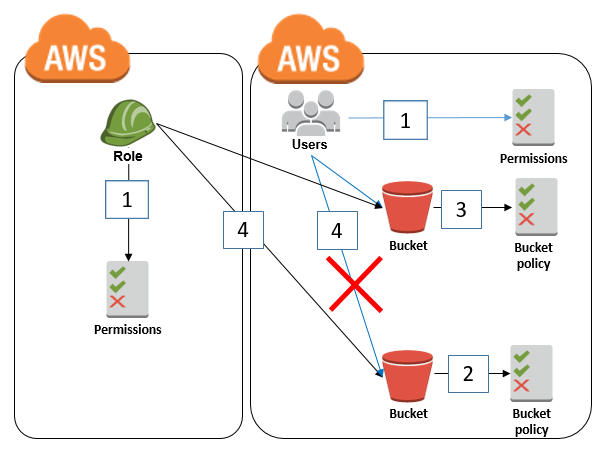AWS Security Blog
Category: Identity
Use scalable controls to help prevent access from unexpected networks
As your organization grows, the amount of data you own and the number of data sources to store and process your data across multiple Amazon Web Services (AWS) accounts increases. Enforcing consistent access controls that restrict access to known networks might become a key part in protecting your organization’s sensitive data. Previously, AWS customers could […]
How to restrict Amazon S3 bucket access to a specific IAM role
February 14, 2025: This post was updated with the recommendation to restrict S3 bucket access to an IAM role by using the aws:PrincipalArn condition key instead of the aws:userid condition key. April 2, 2021: In the section “Granting cross-account bucket access to a specific IAM role,” we updated the second policy to fix an error. […]
Getting started with AWS IAM Identity Center delegated administration
September 12, 2022: This blog post has been updated to reflect the new name of AWS Single Sign-On (SSO) – AWS IAM Identity Center. Read more about the name change here. Recently, AWS launched the ability to delegate administration of AWS IAM Identity Center (AWS IAM Identity Center) in your AWS Organizations organization to a […]
Highlights from the latest AWS Identity launches
August 10, 2022: This blog post has been updated to reflect the new name of AWS Single Sign-On (SSO) – AWS IAM Identity Center. Read more about the name change here. Here is the latest from AWS Identity from November 2020 through February 2021. The features highlighted in this blog post can help you manage […]
Your AWS re:Invent 2019 guide to AWS Identity sessions, workshops, and chalk talks
November 6, 2019: Post updated to include four new sessions — SEC316, SEC317, OIG304, and ACT17. AWS re:Invent 2019 is coming fast! You’ll soon need to prioritize your sessions. Here’s a list of AWS Identity sessions, workshops, and chalk talks at AWS re:Invent 2019. If you haven’t registered yet for re:Invent, here’s a template you […]
AWS re:Invent Security Recap: Launches, Enhancements, and Takeaways
For more from Steve, follow him on Twitter Customers continue to tell me that our AWS re:Invent conference is a winner. It’s a place where they can learn, meet their peers, and rediscover the art of the possible. Of course, there is always an air of anticipation around what new AWS service releases will be […]
Easier way to control access to AWS regions using IAM policies
Update on February 20, 2019: We updated the policy example to remove the “iam:AttachRolePolicy” permission. We also added a reference to the permissions boundaries security blog post to show how to grant developers the permissions to create roles they can pass to AWS services. We made it easier for you to comply with regulatory standards […]
Rotate Amazon RDS database credentials automatically with AWS Secrets Manager
August 31, 2021: AWS KMS is replacing the term customer master key (CMK) with AWS KMS key and KMS key. The concept has not changed. To prevent breaking changes, AWS KMS is keeping some variations of this term. More info. Recently, we launched AWS Secrets Manager, a service that makes it easier to rotate, manage, […]
How to Use Service Control Policies in AWS Organizations
January 20, 2020: Based on customer feedback, we rephrased the fourth goal in the “An example structure with nested OUs and SCPs” section to try to improve clarity. With AWS Organizations, you can centrally manage policies across multiple AWS accounts without having to use custom scripts and manual processes. For example, you can apply service […]
Enable Federated API Access to your AWS Resources for up to 12 hours Using IAM Roles
Now, your applications and federated users can complete longer running workloads in a single session by increasing the maximum session duration up to 12 hours for an IAM role. Users and applications still retrieve temporary credentials by assuming roles using AWS Security Token Service (AWS STS), but these credentials can now be valid for up […]









